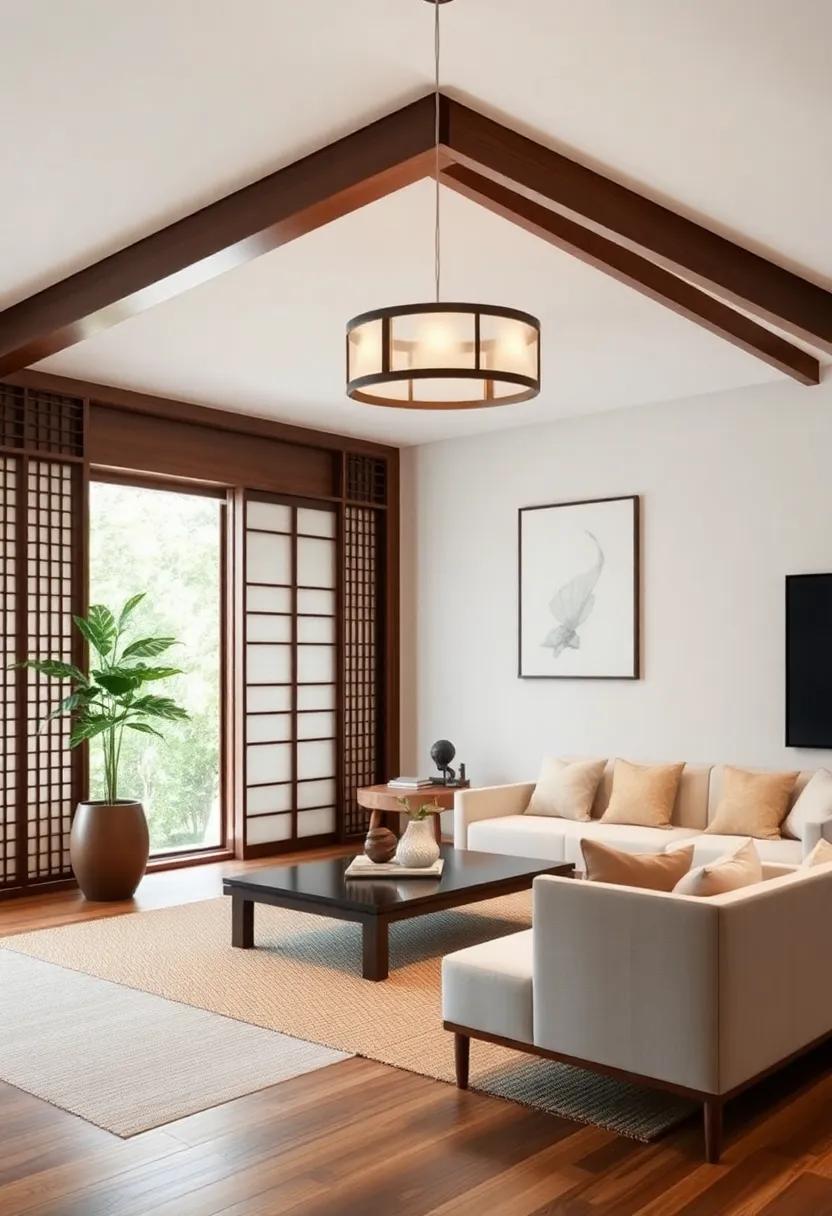In a world that frequently enough feels chaotic and frenetic, the quest for tranquility becomes a cherished goal. The Japanese philosophy of simplicity and harmony offers a pathway to creating serene living spaces that nurture the soul. Embracing tranquility through decor is not merely about aesthetic appeal; it is an invitation to weave peace into the fabric of everyday life. In this article, we will explore the art of Japanese living room decor, highlighting the principles of minimalism, natural elements, and thoughtful arrangement that promote a soothing atmosphere. From the gentle hues of tatami mats to the delicate touch of shoji screens, discover how to transform your home into a sanctuary of calm, allowing serenity to flow through every corner of your living space.Join us on a journey that celebrates the beauty of simplicity and the profound impact it can have on our well-being.
Embracing Minimalism in Japanese Design Principles for a Calm Environment
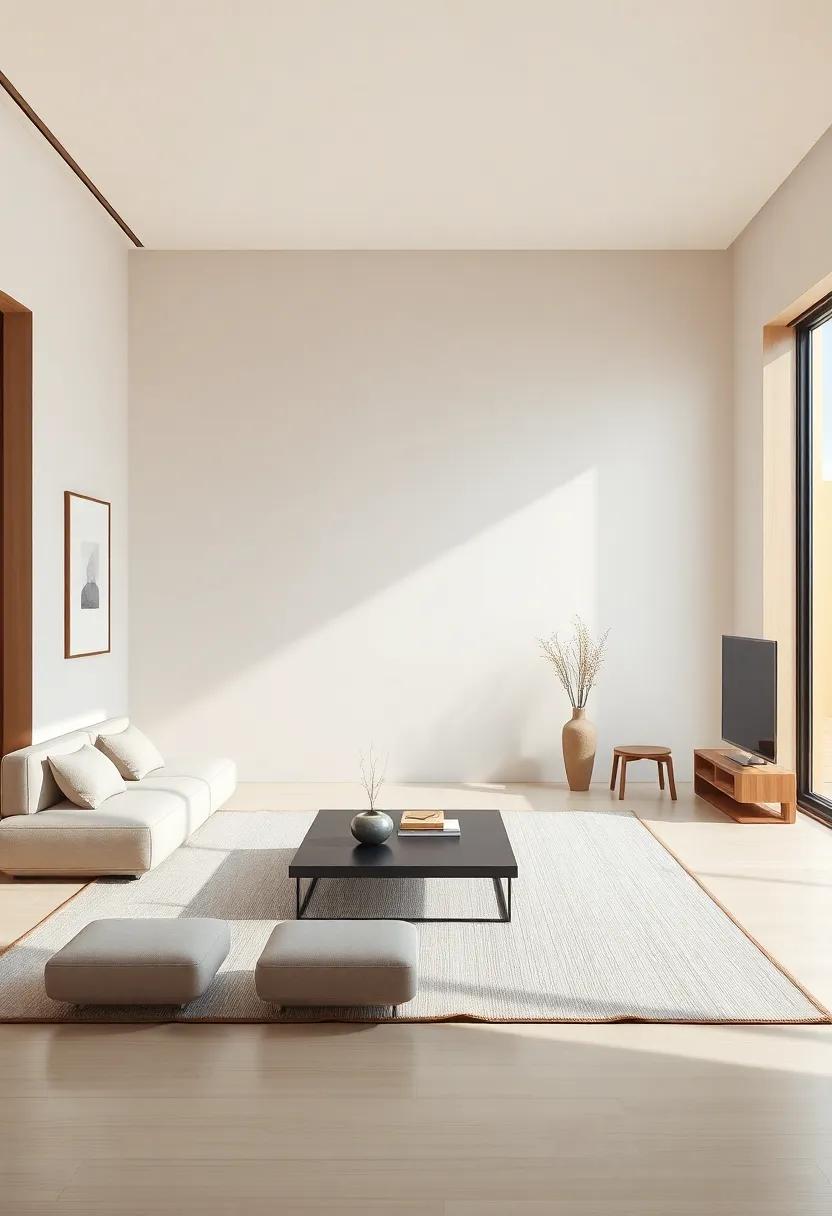
At the heart of Japanese design lies a commitment to simplicity, where each element plays a vital role in creating harmony within the space. By focusing on essential items, you can foster a serene atmosphere that encourages relaxation. the use of natural materials such as wood and stone, neutral color palettes, and soft textiles invites the beauty of the outdoors inside, promoting a sense of calm. Incorporating elements like sliding paper doors (fusuma) or tatami mats not only enhances functionality but also adds an aesthetic quality that reflects a minimalist approach. this design philosophy embraces open spaces, allowing for airflow and flow of energy, which are crucial for a tranquil living environment.
Another key aspect of this design principle is the creation of intentional focal points that draw the eye and evoke appreciation for simplicity. Consider incorporating a single piece of art,a carefully arranged bonsai,or a delicate ceramic tea set as anchors within the room.to further enhance the tranquility, you might include a table to display these focal pieces, emphasizing balance and proportion in your decor. Below is a simple representation of how to integrate these elements effectively:
| Element | Description |
|---|---|
| Natural Materials | Use wood, bamboo, and stone to reflect simplicity and nature. |
| Neutral palettes | Opt for colors like whites, beiges, and soft earth tones. |
| Focal Points | Display items like art or plants to create visual interest. |
| Open Space | Keep areas free from clutter to promote mindfulness and calm. |
The Harmonizing Effect of Natural Light in Japanese Living Room Spaces
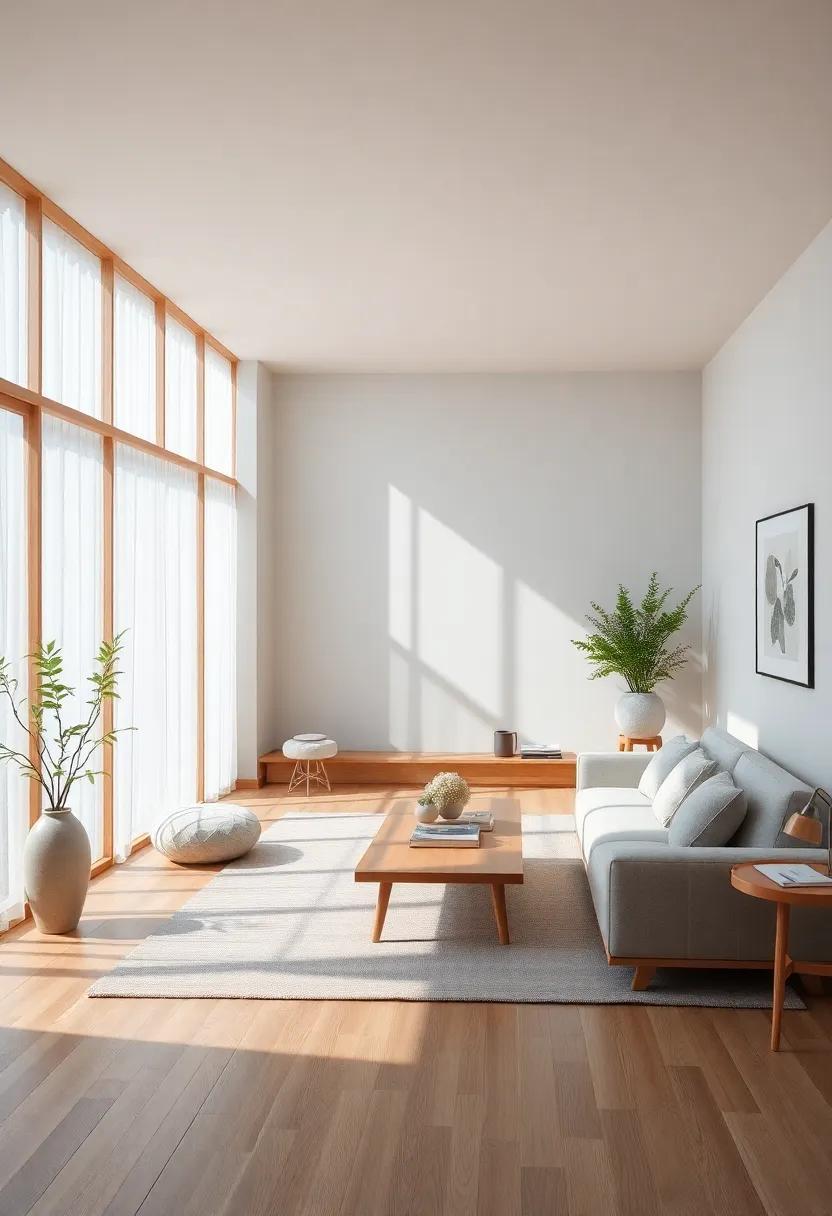
Natural light plays a vital role in Japanese living room design, enhancing the overall ambiance by creating a serene and inviting space.The gentle illumination from large windows or sliding shoji screens casts soft shadows and highlights the beauty of minimalist decor. This harmonious interplay of light and space encourages a connection with nature, blurring the lines between the indoors and outdoors. Rooms bathed in natural light promote relaxation and mindfulness, fostering an environment where family members can gather in tranquility.
to optimize the calming properties of natural light, consider incorporating various design elements, such as:
- large Windows: Allow ample sunlight to fill the room.
- Sliding Shoji Screens: Offer versatility in light control while maintaining aesthetics.
- Light Color Palettes: Use neutral tones that reflect light effectively.
- Wooden Elements: Bring warmth and organic textures to complement natural illumination.
In addition, the strategic arrangement of furniture can enhance the effects of light. A well-positioned futon or tatami mat can catch the sun’s rays, creating a cozy nook for relaxation or meditation.Below is a simple guide to enhance light flow in your living room:
| design Element | Effect on Light |
|---|---|
| Reflective surfaces | Amplifies brightness and creates a spacious feel. |
| Translucent Fabrics | Softens harsh sunlight while allowing light diffusion. |
| Open Floor Plans | Encourages an unobstructed flow of natural light. |
Incorporating Traditional Tatami Mats for an Authentic Touch of Serenity
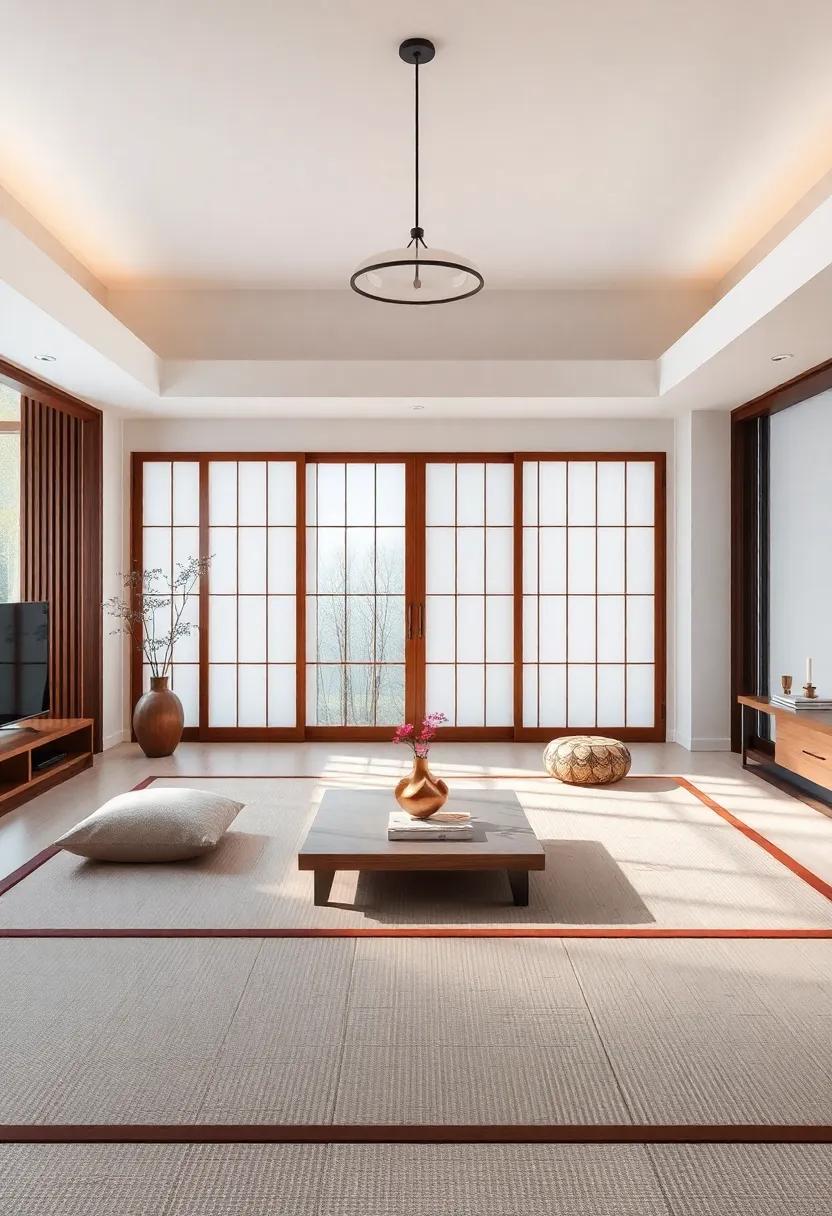
Integrating traditional tatami mats into your living space not only pays homage to japanese culture but also creates a serene and grounding atmosphere. These mats,made from rice straw and covered with woven rush grass,bring a unique texture and warmth to any room.By laying tatami mats across a wooden or tiled floor, you transform the environment into a tranquil retreat that invites relaxation and mindfulness. Thier natural material promotes a soothing ambiance, reducing noise and enhancing comfort, making them ideal for a peaceful home.
To fully embrace the essence of tatami mats, it’s essential to consider their arrangement and the decor that surrounds them. Here are some elements to complement your tatami setting:
- Low Furniture: Incorporate low tables and seating to maintain the harmony of the floor space.
- Natural Light: Utilize sheer curtains to allow diffused light, enhancing the calming effect of your decor.
- Sustainable Accents: Add bamboo or wooden accessories to highlight the organic feel of the tatami.
- Minimalist Art: Choose simple wall art reflecting nature to resonate with the tranquility of tatami mats.
When planning your layout, consider the following aspects of tatami arrangement:
| Aspect | Consideration |
|---|---|
| Orientation | Position mats in a way that encourages flow and openness in the space. |
| Maintenance | Regularly clean mats with a vacuum or cloth to preserve their integrity and beauty. |
| Size | Choose sizes that fit the dimensions of your room to create balance and proportion. |
By thoughtfully incorporating tatami mats into your decor, you can elevate your living space into a serene sanctuary, reflecting the tranquil essence of Japanese design.
Curating a Color Palette inspired by Nature’s Subtle Tones
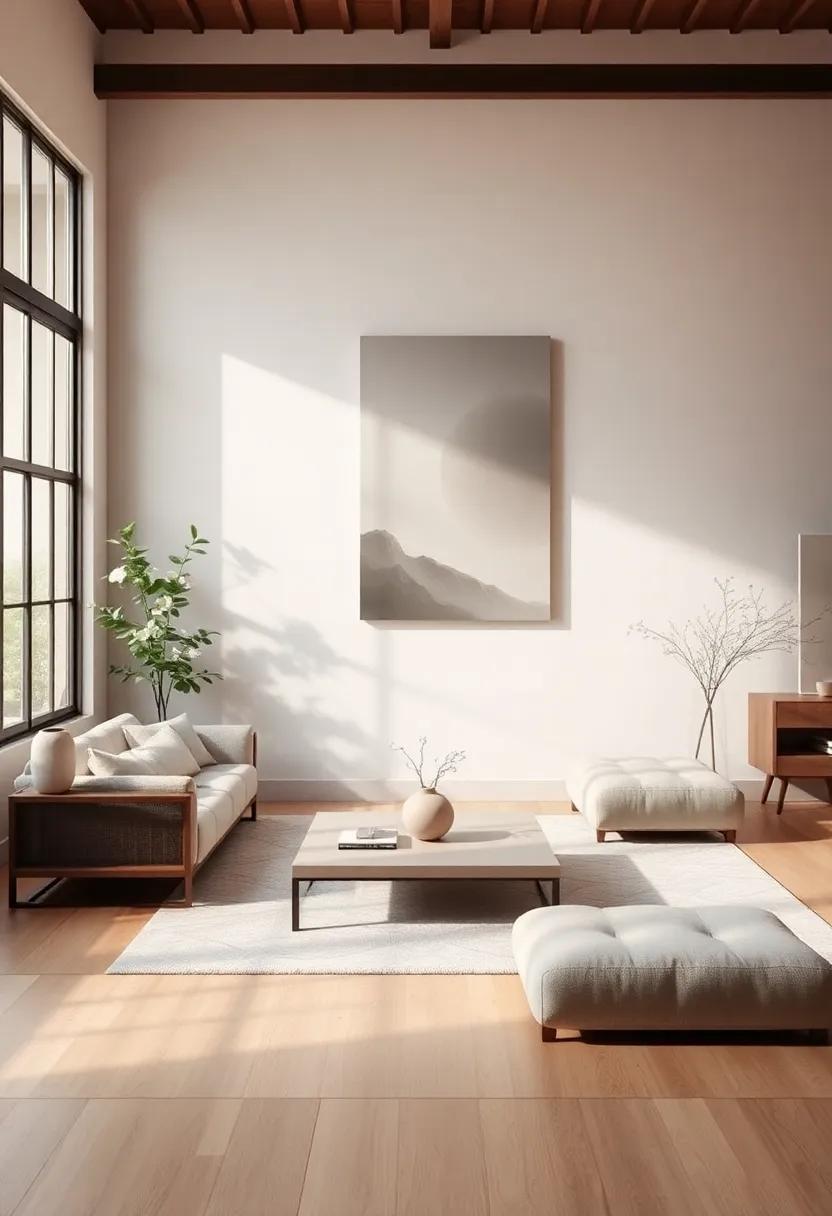
To achieve the serene atmosphere characteristic of traditional Japanese interiors, consider assembling a color palette that mirrors the gentle hues found in nature.Think of soft greens, reminiscent of bamboo leaves swaying gently, and muted earth tones that echo the rich soil and stones of a tranquil garden. Incorporating shades like blush pink, inspired by cherry blossoms, can subtly enliven the space, while cool grays and warm beiges provide a grounding backdrop that promotes relaxation and calm. By harmonizing these colors, you create a soothing environment that invites peace into your living space.
In order to effectively curate this palette, you can utilize various natural elements that serve as inspiration. Here are a few suggestions to help you visualize the perfect selection:
- Bamboo Green: A light, airy shade that brings the essence of lush forests indoors.
- Stone Gray: Reflective of aged stones, it adds depth and balance to the decor.
- Sakura Pink: Capturing the fleeting beauty of cherry blossoms, this adds warmth and a touch of softness.
- Sand Beige: Evoking the tranquility of beaches, it grounds the room and complements other elements.
| Color | Inspiration | Suggested Use |
|---|---|---|
| Bamboo Green | bamboo forests | Cushions, wall accents |
| Stone Gray | Aged stones | |
| Sakura Pink | cherry blossoms | Artwork, vases |
| Sand Beige | Peaceful beaches | Walls, furniture |
The Role of Soft Textiles in Creating Cozy and Inviting Spaces
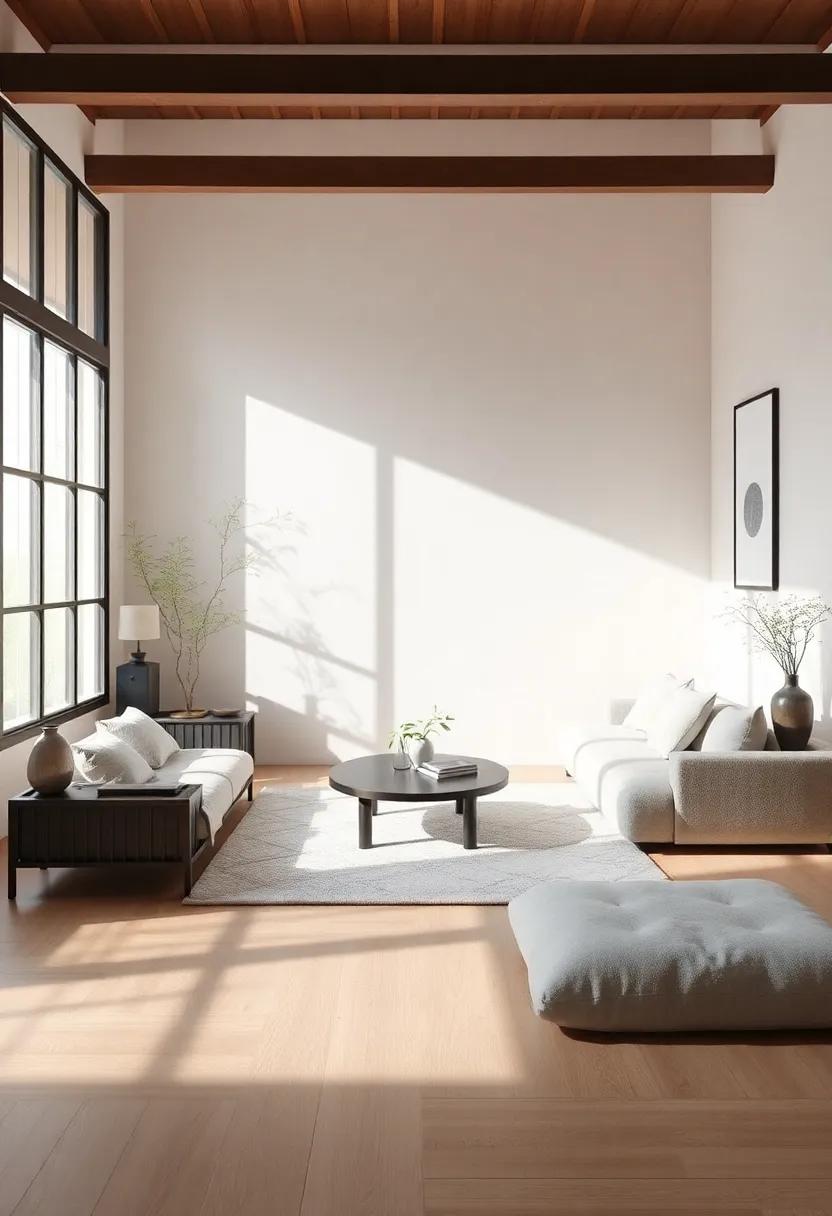
Soft textiles serve as the quiet heroes in the quest for a tranquil atmosphere, infusing warmth and comfort into contemporary Japanese living spaces. Natural fibers like linen, cotton, and wool not only offer a tactile softness but also allow for breathability, essential in creating a serene environment. Layering cushions,throws,and rugs that resonate with muted colors and earthy tones can transform a stark space into a cozy haven. Textured fabrics,from plush throws to knitted poufs,can be strategically placed to invite relaxation and encourage a sense of calm,turning a simple setting into a nurturing refuge.
In a thoughtfully curated room, soft textiles also play a pivotal role in defining zones and guiding movement within the space. Flowy curtains can frame windows, filtering light in a way that soothes the senses, while tatami mats provide both aesthetic appeal and tactile comfort underfoot. An assortment of decorative pillows arranged thoughtfully can create inviting seating nooks, encouraging social interaction or solitary tranquility. Here’s a brief overview of soft textiles that can enhance the cozy backdrop of a Japanese living room:
| Textile Type | Key Benefit |
|---|---|
| Linen | Breathable and lightweight,perfect for layering. |
| Wool | provides warmth and textured depth. |
| cotton | Offers softness and easy maintenance. |
| Silk | Luxurious feel adds elegance to any decor. |
Integrating Shoji Screens for a Perfect Balance of Privacy and Light
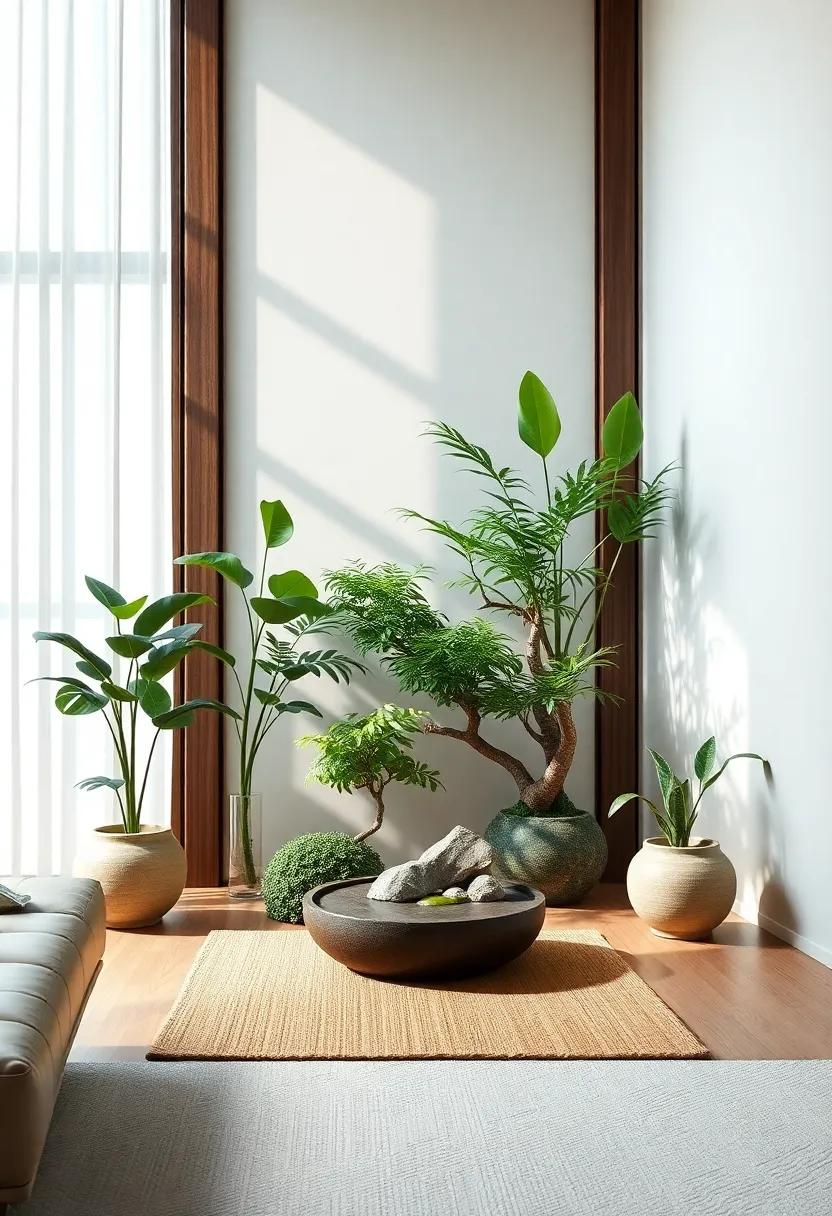
Incorporating Shoji screens into your living room design offers an elegant solution for achieving both privacy and natural light. These traditional Japanese sliding panels, crafted from a delicate frame and translucent paper, allow diffused sunlight to fill your space while cleverly separating areas for a tranquil, serene atmosphere. When positioning your Shoji screens, consider the following benefits:
- Soft Light: They gently filter sunlight, creating a warm, inviting glow throughout the room.
- Flexible Spaces: Easily movable, they allow for quick adjustments in your layout to accommodate gatherings or quiet moments.
- Visual Interest: Their intricate designs add an artistic element, enhancing your decor’s overall aesthetic.
To maximize their functionality, you can combine Shoji screens with different materials and colors that mirror your home’s palette. Pairing these screens with furniture in natural woods and muted tones creates a cohesive look, fostering a sense of harmony. For those looking to elevate their interior,consider placing a small table next to the Shoji screens to create a cozy nook for tea or reading. The table can be styled simply, like this:
| Item | Description |
|---|---|
| Tea Set | delicate porcelain set for an authentic experience. |
| Throw Pillows | Soft cushions in natural fabrics to encourage relaxation. |
Selecting Furniture with Clean Lines and Gentle Curves for Relaxation
When curating a serene living space, the choice of furniture plays a pivotal role in fostering a calming environment. Opt for pieces that feature clean lines to maintain a sense of order and simplicity. These designs evoke the essence of minimalism, which is at the heart of Japanese decor. Pairing these with gentle curves helps establish a sense of softness and comfort, inviting relaxation. Look for furniture such as:
- Low-profile sofas with straight edges.
- Simple wooden coffee tables with rounded edges.
- Organic-shaped accent chairs that encourage lounging.
In addition to aesthetics, incorporating natural materials—such as bamboo, rice paper, and light-toned woods—enhances the tranquil vibe. These elements not only provide visual appeal but also connect your space to the serene beauty of the outdoors. Consider the following table of material options and their benefits:
| Material | Benefits |
|---|---|
| Bamboo | Lightweight, sustainable, and adds warmth. |
| Rice Paper | Softens light and creates a serene atmosphere. |
| Light-toned Wood | Brings nature indoors and promotes calmness. |
Bringing Nature Indoors with Indoor Plants and Zen Gardens
Incorporating indoor plants into your living space not only enhances the aesthetic appeal but also fosters a sense of calm and well-being. The vibrant greens and varied textures of plants can create a refreshing atmosphere, inviting the soothing qualities of nature into your home. Consider adding plants such as:
- Peace Lily – Known for its air-purifying properties and elegant white blooms.
- Snake Plant – A hardy plant that thrives in low light, offering sculptural form.
- Fiddle Leaf Fig – Popular for its dramatic leaves, making a bold statement.
- Bamboo Palm – A classic choice for achieving an exotic feel while improving indoor air quality.
Zen gardens, meanwhile, serve as a tranquil focal point that encourages mindfulness and reflection. These miniature landscapes allow you to create a peaceful retreat within your home where you can unwind. To craft your own Zen garden, consider these essential elements:
- Sand or Gravel – For the base, representing water and providing a blank canvas for creativity.
- Rocks – Symbolizing mountains, adding texture and visual interest.
- Tools – A rake to create patterns in the sand, promoting relaxation as you engage in this mindful activity.
| Element | Meaning |
|---|---|
| Sand | Represents water and serves as a calming base. |
| Rocks | Symbolize mountains, adding stability and focus. |
| Plants | Introduce life and nature’s essence. |
| Care Tools | Encourage mindfulness and personal interaction. |
Artful Display of Decorative Elements for a Clutter-Free Aesthetic
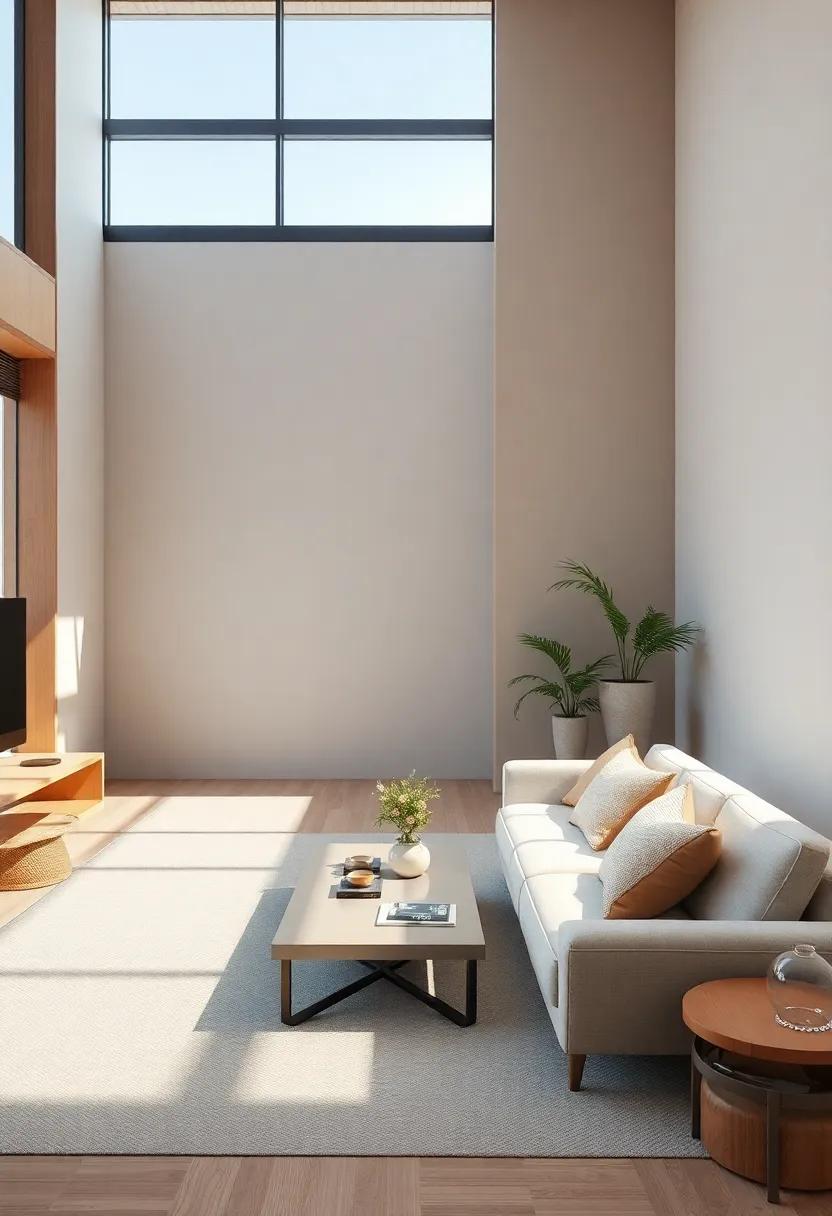
Achieving a serene and clutter-free atmosphere in your Japanese living room requires a careful selection of decorative elements that enhance tranquility while maintaining functionality. Natural materials, such as wood, stone, and woven textiles, can be beautifully integrated to create a harmonious environment. Consider using the following elements to maximize the aesthetic appeal:
- Minimalist Artwork: Simple, nature-inspired pieces that evoke calmness.
- bamboo Accents: Plants or decorative items that bring life without overwhelming the space.
- Soft Lighting: Paper lanterns or wall sconces that cast a warm, inviting glow.
To elevate the experience of your living room,ensure that each decorative element serves a purpose and complements the overall design.A thoughtful arrangement can feature a mix of functional and artistic items, creating a cohesive look. Here’s a table to illustrate some ideal combinations:
| Element | function | Aesthetic Value |
|---|---|---|
| Low Wooden Table | Dining or tea ceremonies | Warmth and authenticity |
| Shoji screens | Room partitioning | Soft light diffusion |
| Woven Mats | Flooring comfort | Textural richness |
Creating Focal Points with Statement pieces in a Zen-Inspired Room
In a serene Japanese-inspired living space, the use of statement pieces not only enhances the aesthetic but also draws attention to specific areas, creating unexpected focal points. Integrating elements such as a large, intricately carved wooden relief or a handcrafted pottery vase can transform a simple corner into a tranquil retreat. These striking additions should reflect the principles of minimalism and harmony, ensuring that they resonate with the tranquil vibe of the room. Consider these statement pieces for achieving balance and attraction:
- Large Artwork: A calming landscape painting or abstract piece that evokes the beauty of nature.
- Unique Furniture: A beautifully designed low-profile coffee table made of natural wood.
- Natural Elements: An indoor water feature or a Zen garden that promotes tranquility.
Additionally, achieving balance through color and texture is essential to highlight these eye-catching items. When choosing statement pieces, select colors from a harmonious palette that aligns with the overall decor. Incorporate textiles like soft cushions or throws in serene hues to further emphasize these focal points smoothly. Consider creating a visual hierarchy by placing smaller decorative items around larger statement pieces, establishing a cohesive flow that draws the eye while maintaining a sense of calm. Effective ways to arrange these elements include:
| Element | Purpose |
|---|---|
| Statement Artwork | Acts as the anchor of the room, setting the mood. |
| large Plants | Adds life and freshness, enhancing tranquility. |
| natural Textures | Introduces warmth and comfort, creating layers of interest. |
Balancing Functionality and Aesthetics in Japanese interiors
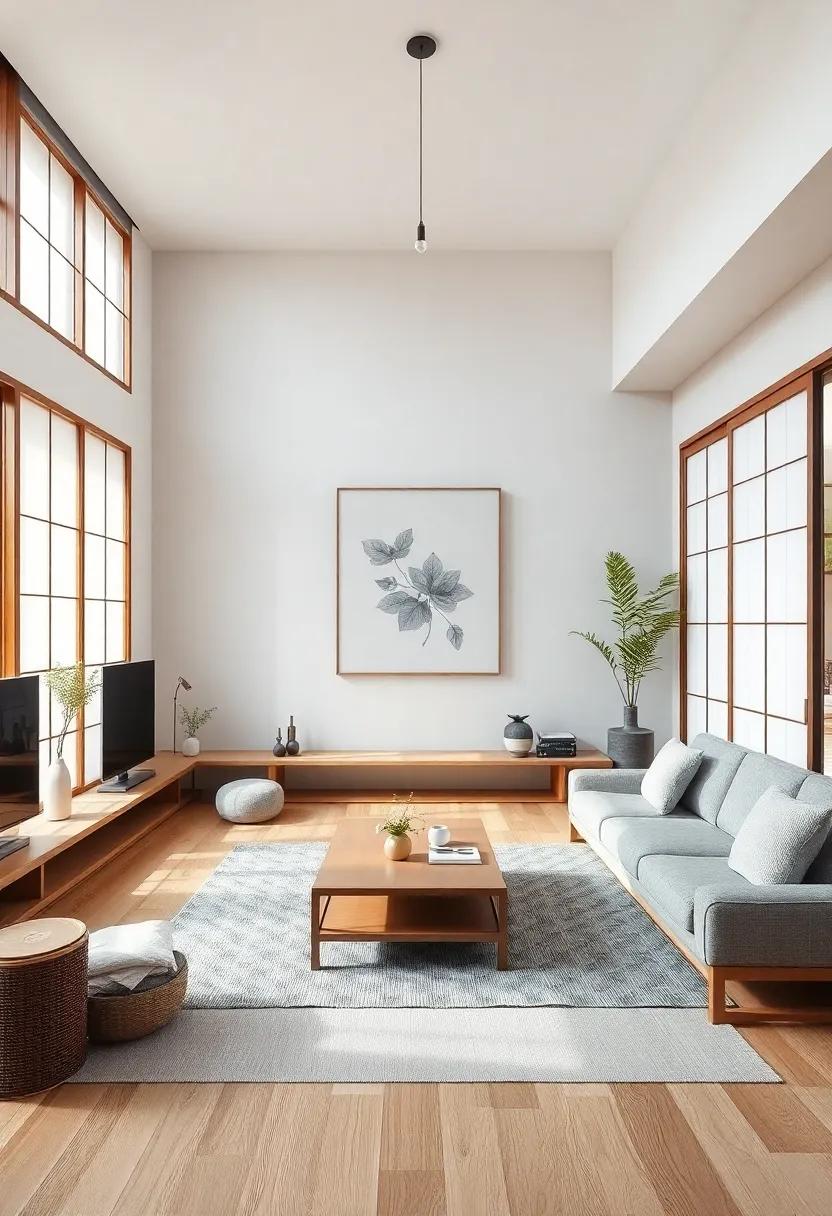
Japanese interiors are renowned for their seamless blend of functionality and aesthetics, creating living spaces that are both visually appealing and practical.The use of natural materials, such as wood and stone, reflects a commitment to simplicity and sustainability. Tatami mats serve as both flooring and an element of comfort, inviting guests to sit and relax, while sliding shoji screens not only enhance the spatial flow but also allow for adaptable layouts that accommodate various activities. The approach emphasizes uncluttered spaces,encouraging a mindful existence and fostering a connection to nature. Essential decor items like a kintsugi vase or handcrafted pottery contribute character without overwhelming the room, embodying the Japanese philosophy of wabi-sabi—finding beauty in imperfection.
Incorporating thoughtfully curated elements enhances the calming ambiance of a living room while ensuring it remains a space of utility. Key components often include:
- Low furniture: Low tables and floor cushions prioritize comfort and encourage social interaction.
- Neutral color palettes: Soft hues create a serene backdrop that allows decor pieces to stand out.
- Natural light: Large windows or skylights bring the outdoors in, promoting a tranquil environment.
- Zen-inspired plants: Bonsai or bamboo introduce a splash of green without cluttering the space.
These elements invite tranquility into the home while ensuring that each piece serves a practical purpose. Understanding the interplay between practicality and beauty allows for the creation of spaces that are not only stylish but also support a calm, organized lifestyle.
Exploring the Tranquil Influence of Water Features in Indoor Design
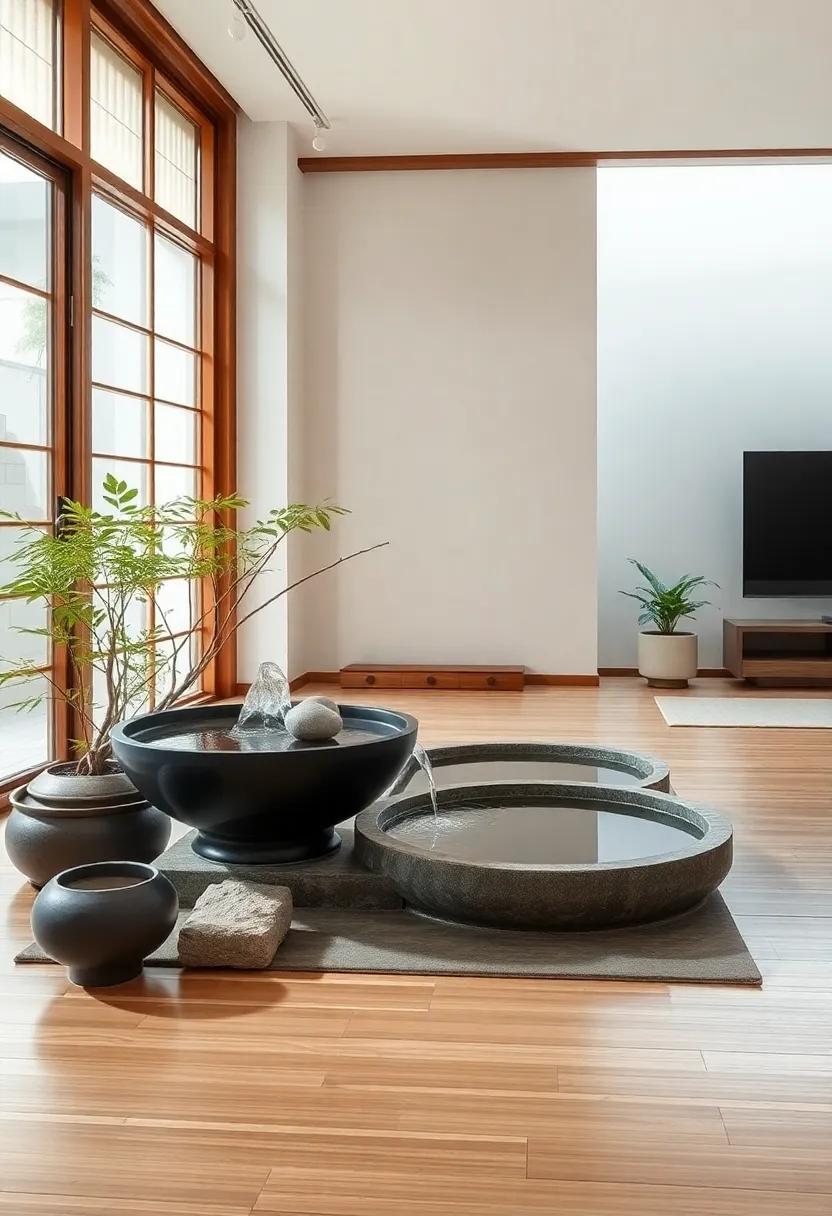
Water features introduce a calming presence into indoor spaces, enhancing the atmosphere with their soothing sounds and gentle movements.Incorporating elements such as indoor fountains, small ponds, or even aquariums can create a serene haven reminiscent of traditional Japanese aesthetics. The soft burbling of water can dissolve the noise of daily life, inviting a sense of peace and contemplation into the room. Strategically positioning these features not only promotes a sense of balance but also reflects the beauty of nature, encouraging harmony within the living space.
In designing a tranquil indoor environment, consider the following aspects when selecting water features:
- Size and Scale: Choose a size that harmonizes with your living space; larger rooms can accommodate grander pieces, while smaller areas benefit from minimalist designs.
- material Selection: Using natural materials like stone or bamboo can enhance the overall theme; these choices echo the organic elements prevalent in Japanese decor.
- Lighting Effects: Integrate soft lighting around the water feature to create a peaceful ambiance, playing with shadows and reflections to elevate the tranquility of the setting.
| Water Feature Type | Benefits |
|---|---|
| Indoor Fountain | Enhances air quality & creates a tranquil sound. |
| Aquarium | Brings vibrant life, fostering relaxation and focus. |
| Zen Garden with Water | Encourages mindfulness and meditation through its simplicity. |
Utilizing Low Furniture to Foster a Sense of Groundedness
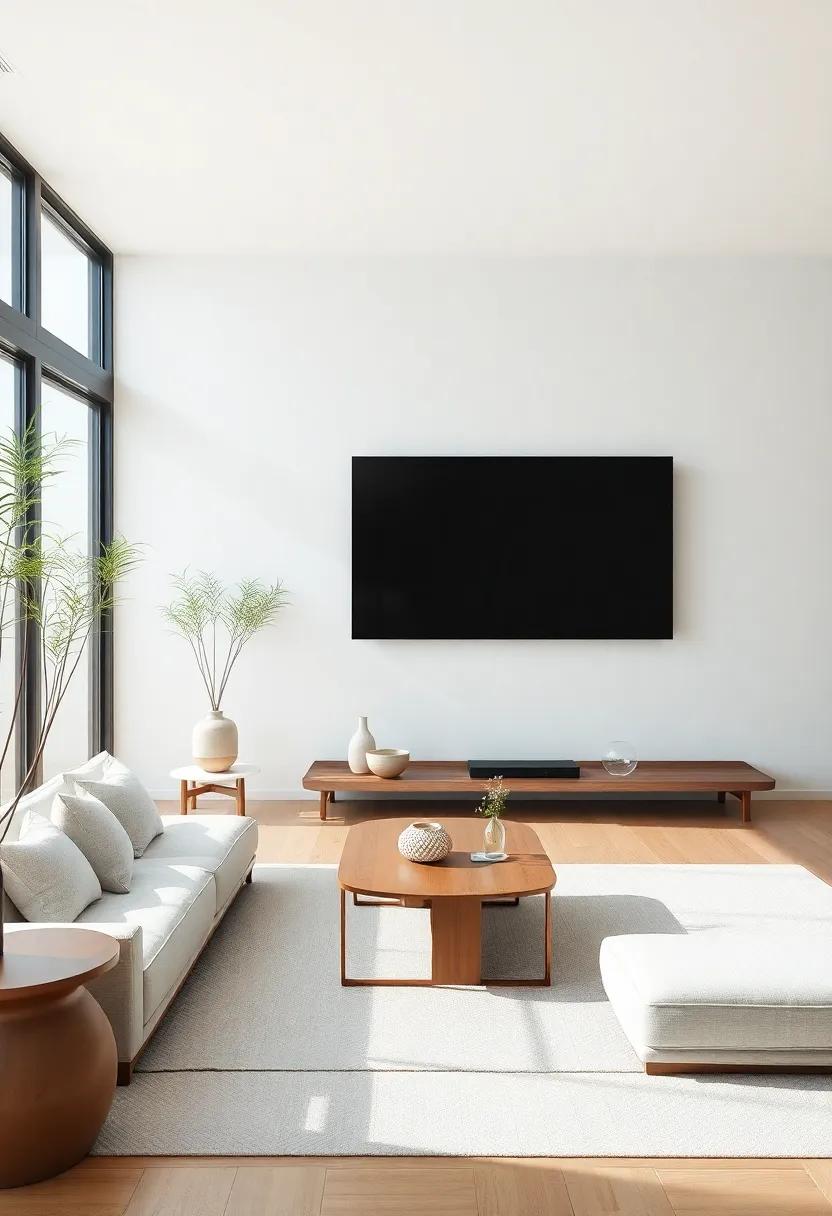
Incorporating low furniture into your living space serves not just an aesthetic purpose but also creates a profound sense of connection to the Earth. Low tables, floor cushions, and simple rugs can transform a room from a conventional sitting area into a peaceful retreat. This design choice encourages a more intimate and inviting atmosphere, where individuals naturally gravitate towards each other, facilitating conversation and relaxation. By adopting a horizontal layout, the visual weight of the room decreases, promoting an airy feeling that enhances tranquility.
When selecting low-profile furnishings, consider these essential elements that reflect the serene essence of Japanese aesthetics:
- Natural Materials: Opt for wood, bamboo, or rattan to evoke a warm and organic ambiance.
- Neutral Palette: Soft colors promote relaxation; think muted earth tones or gentle pastels.
- Simplicity: Choose pieces with minimal ornamentation to maintain a clean and uncluttered space.
Additionally, positioning these pieces in a way that enhances accessibility can further increase the feeling of groundedness. For a harmonious arrangement, consider the following layout:
| Furniture Type | Recommended placement |
|---|---|
| Low Coffee Table | Center of the seating area |
| Floor Cushions | Surrounding the coffee table |
| Low Bookshelf | Along the wall for easy access |
Inspiring Serenity Through Thoughtfully Curated Artwork and Decor
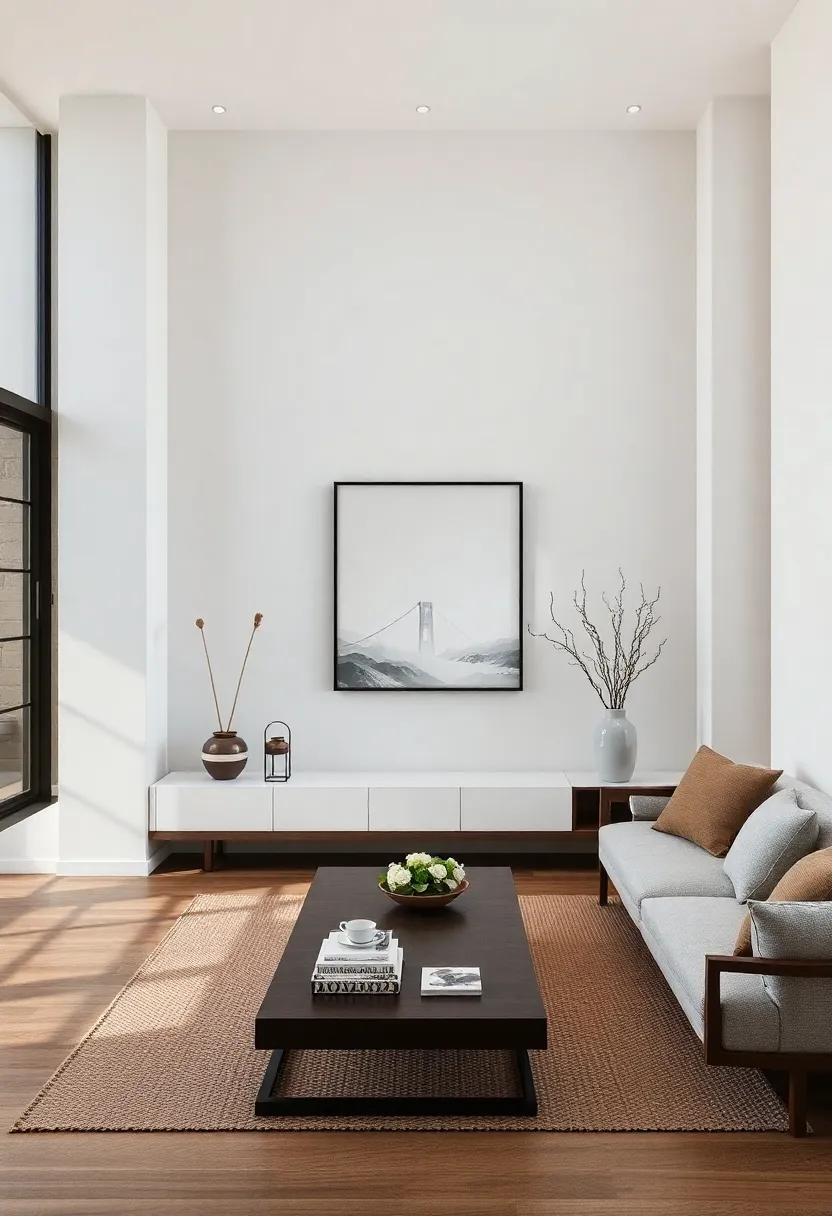
In the quest to achieve tranquility within a living space, the selection of artwork and decor plays a pivotal role. Thoughtfully chosen pieces can evoke a sense of calm,transporting us to serene landscapes and elegantly simple aesthetics. Like a gentle breeze rustling through bamboo leaves, the right elements whisper peace into our lives.Consider incorporating natural motifs such as:
- japanese ink paintings featuring tranquil landscapes
- Minimalist sculptures that reflect harmony and balance
- Textiles with subtle earth tones to soften the atmosphere
Additionally, embracing the beauty of simplicity in decor can aid in creating a sanctuary that nurtures the soul. choosing pieces that harmonize with one another and contribute to a cohesive narrative fosters a more peaceful environment. To illustrate this, here’s a quick overview of decor elements that embody this philosophy:
| Decor Element | Description |
|---|---|
| Futons | Comfortable, versatile seating that promotes relaxation. |
| Shōji screens | Light-filtering dividers that create private spaces. |
| Simplistic vases | Centerpieces that highlight nature without overpowering. |
The Importance of Open Spaces for Breathability and Calmness
Open spaces serve as vital lungs for our living environments, providing much-needed breathability in today’s increasingly crowded and cluttered homes. Japanese culture emphasizes minimalism and the profound connection between nature and living spaces, encouraging the integration of elements that foster tranquility. With a careful arrangement of furniture and mindful selection of colors and materials, these spaces allow for both physical and mental openness, enabling residents to feel at ease. Key aspects of creating such serene environments include:
- natural Light: Maximizing exposure to sunlight can uplift moods and energize the spirit.
- Uncluttered Layout: A tidy space reduces stress and promotes calmness.
- Nature Elements: Incorporating plants invites vitality and fresh air, enhancing well-being.
Moreover, the balance of space plays a crucial role in promoting serenity.With elements like shoji screens, Tatami mats, and low-profile furniture, Japanese design creates an inviting aesthetic that encourages relaxation and peace. The intentional gaps and open areas foster a sense of freedom, allowing for fluid movement and an uncluttered mind. To achieve this harmonious presence in your home, consider these fundamental components of a peaceful living area:
| Element | Impact on Calmness |
|---|---|
| Simplicity | Reduces visual noise for a clearer mind |
| Natural Materials | Brings the outdoors in for a grounded feeling |
| Soft Colors | Creates a soothing palette that eases tension |
Crafting Cozy Nooks for Reflection and Mindfulness Practice
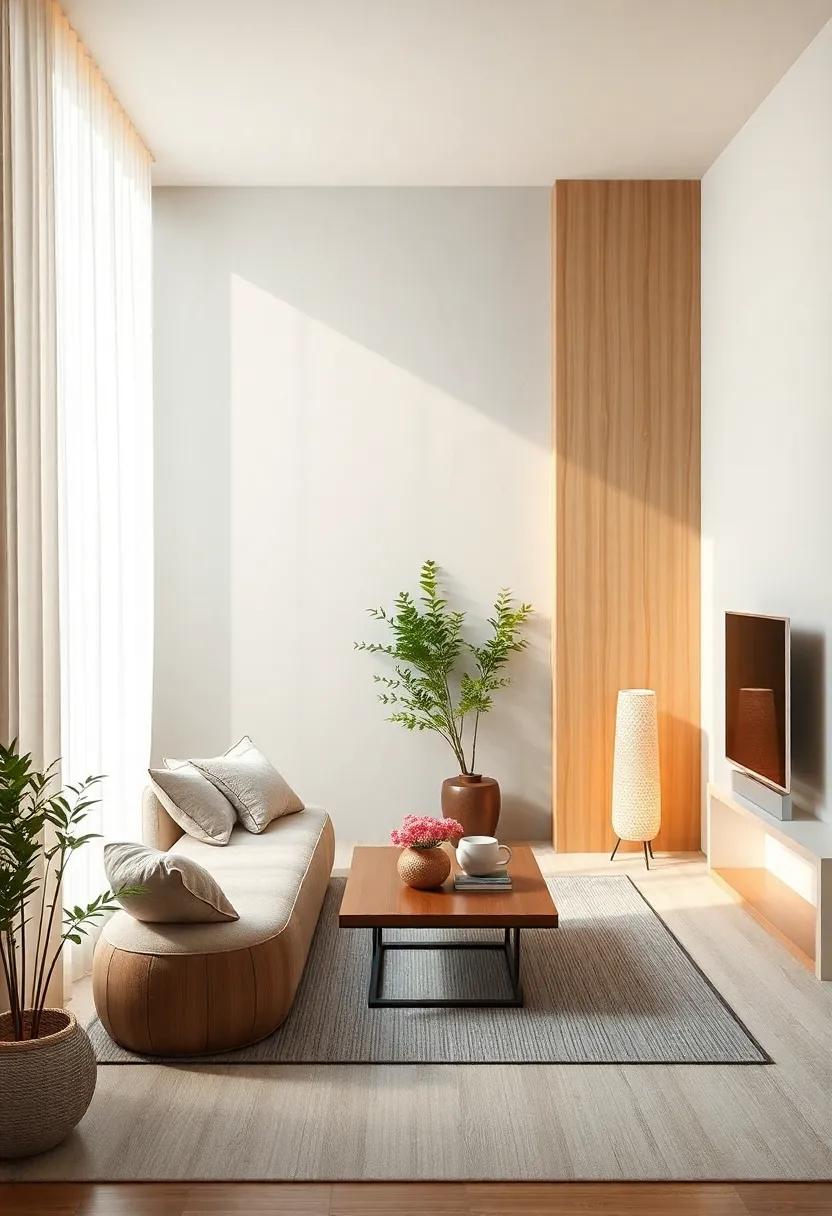
Creating intimate spaces within your living area can greatly enhance your mindfulness practice. Natural elements, such as bamboo mats or tatami flooring, foster a connection to the earth, while soft, muted colors create a calming atmosphere. Layering textures through silk cushions or light cotton throws offers both comfort and aesthetic appeal, inviting you to settle in for moments of reflection. Incorporating plants, like the peace lily or bamboo, not only improves air quality but also adds a fresh, vibrant energy to your nook, helping to promote a tranquil vibe.
Consider incorporating simple yet purposeful decor elements that resonate with the principles of Zen. A low, minimalist table can serve as a focal point, perfect for placing a fragrant scented candle or a handcrafted tea set—all essential for creating a serene ritual. Utilize soft lighting, such as paper lanterns or dimmable fixtures, to establish a serene ambiance.Below is a simple guide to elements that enhance a peaceful reflection space:
| Element | Purpose |
|---|---|
| Natural Textiles | Comfort and warmth |
| Indoor Plants | Air quality and serenity |
| Low Furniture | Encourages relaxation |
| Soft Lighting | Creates a calming atmosphere |
| Decorative Candles | Enhances mindfulness rituals |
the power of Fragrance and Sound in Cultivating a Peaceful Atmosphere
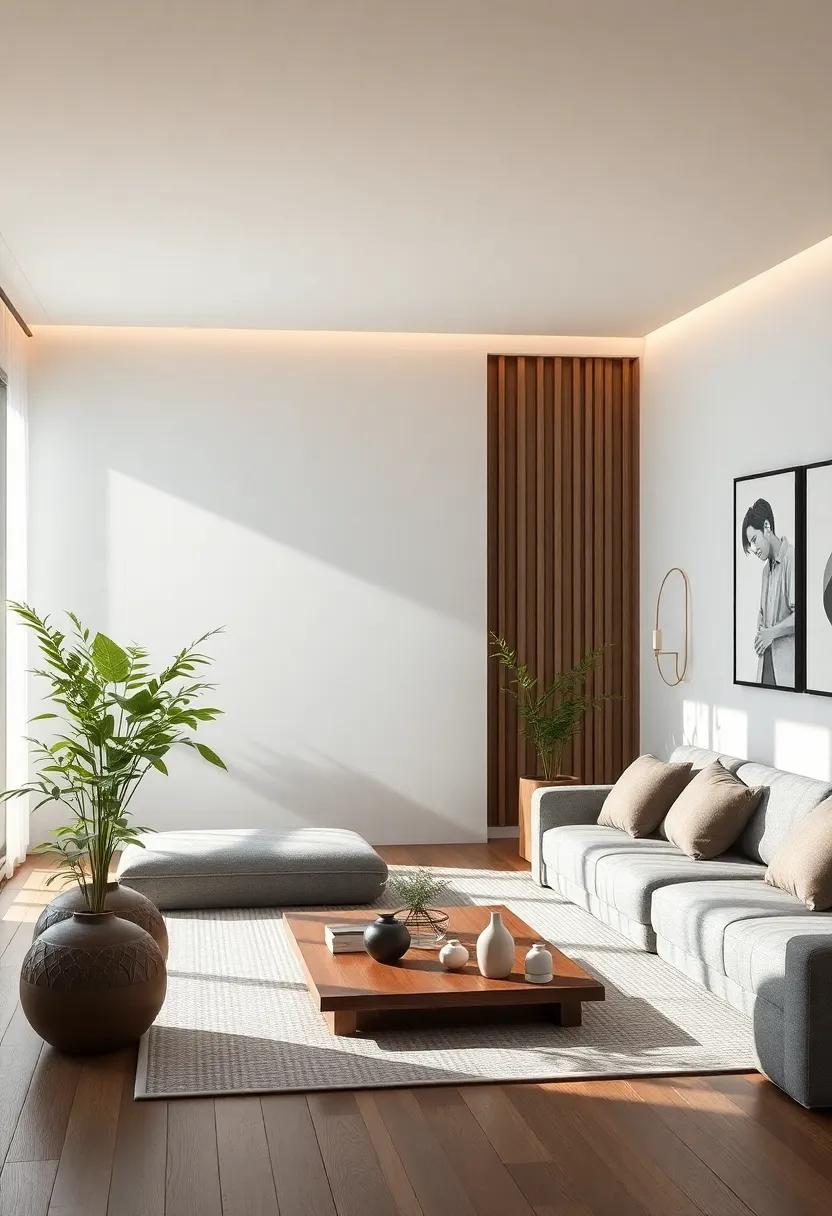
In the serene atmosphere of a Japanese living room, the harmony created by fragrance and sound plays a vital role in fostering peace and relaxation. As fragrant aromas waft through the air, they can evoke a sense of calm and well-being, offering a respite from the daily hustle. Natural scents, such as cherry blossom, green tea, and citrus, not only enhance the sensory experience but also connect us to nature, echoing the ethos of traditional Japanese aesthetics. Integrating essential oil diffusers or incense holders with subtle, elegant designs can further elevate this serene environment.
Complementing the olfactory experience is the gentle soundscape that invites tranquility into the space. The subtle melodies of nature—like the soft rustle of leaves or the distant trickle of water—create a soothing backdrop. Consider incorporating elements such as traditional bamboo flutes, wind chimes, or even ambient soundscapes that align with the calming principles of Japanese decor. utilizing these auditory elements creates a sensory tapestry that envelops the room, allowing for an immersive experience of serenity.
Transforming Lighting with Subtle, Adjustable Options for Ambient Harmony
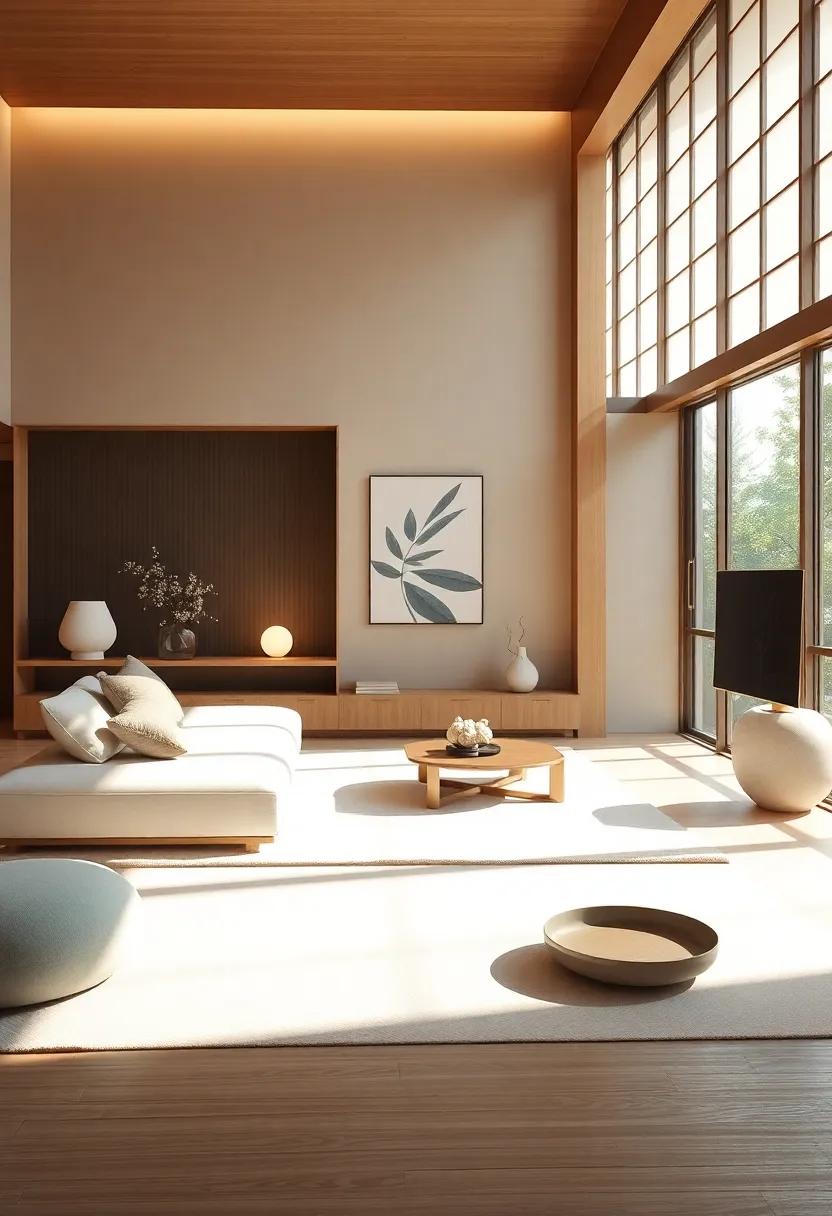
The essence of a tranquil living space lies in its ability to adapt to the varied moods of its occupants. by integrating subtle, adjustable lighting options, one can effortlessly cultivate an atmosphere of calm and serenity. The gentle glow of shoji lamps, paired with modern dimmers, allows you to control the brightness, creating an intimate space perfect for quiet reflection or cozy gatherings. These lighting sources not only illuminate the room but also enhance the natural materials and earthy color palettes typical in Japanese decor.
Incorporating a mix of soft LED strips and traditional lanterns can further elevate the ambiance. Consider the following options for a harmonious lighting scheme:
- Paper Lanterns: Provides a soft, diffused light.
- Wall Sconces: Adds architectural interest while offering adjustable brightness.
- Floor Lamps: Ideal for reading nooks with adjustable shades.
- Dimmer Switches: Allow easy transitions from vibrant to restful light.
These choices not only enhance the beauty of your decor but also resonate with the fundamental principles of Japanese aesthetics, where simplicity and functionality go hand in hand. By paying attention to how light interacts with your space, you can weave a tapestry of tranquility that invites peace and mindfulness into everyday life.
Integrating Cultural Artifacts to Tell a Story in Your Serene Space
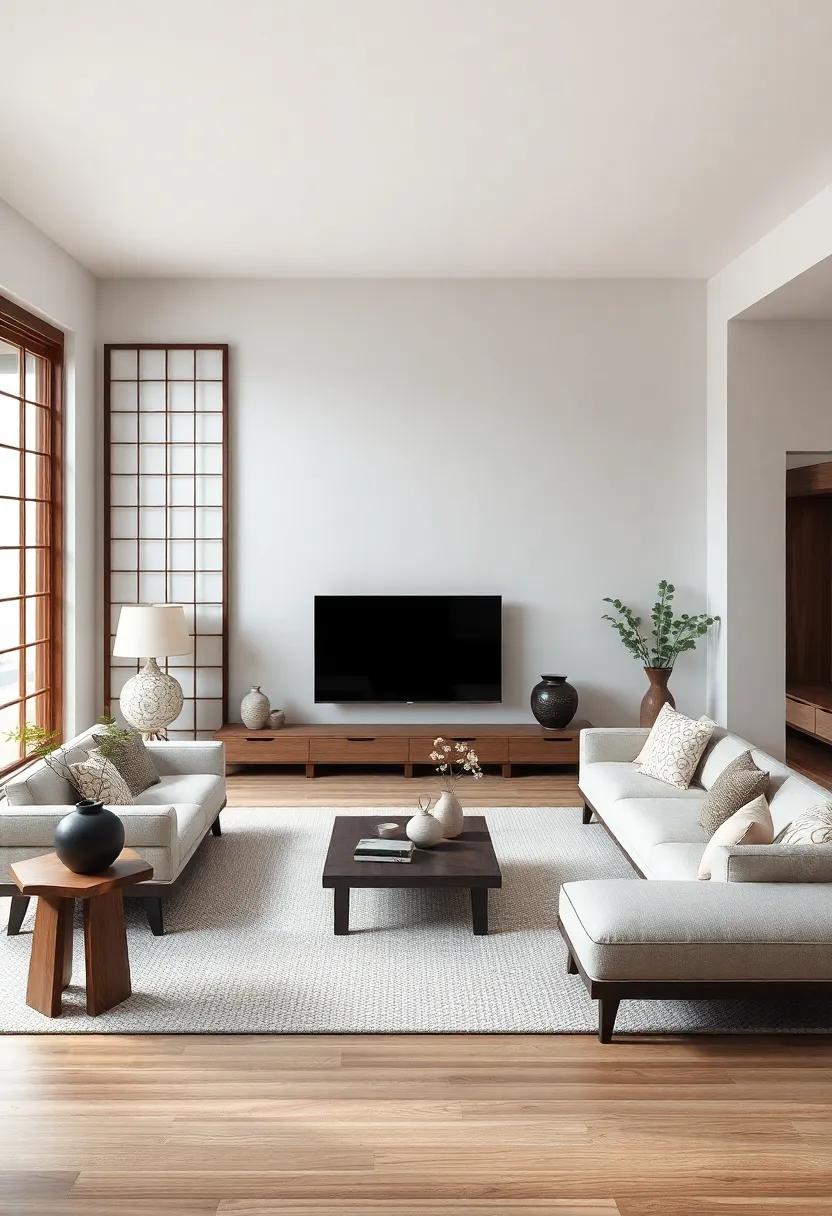
In the serene oasis of a Japanese-inspired living room,integrating cultural artifacts serves as a bridge to connect history,creativity,and tranquility. each piece tells a story, inviting reflections of traditional craftsmanship and timeless aesthetics. Consider incorporating ceramic pots adorned with intricate patterns, symbolizing harmony and stability. Add delicate calligraphy scrolls featuring inspiring verses that resonate with peace and mindfulness. Sculptural elements such as shoji screens can offer dual functionality—dividing space and providing soft, diffused light that creates a meditative atmosphere.
When selecting artifacts, aim for a balance that enhances serenity rather than clutter. Here are some suggestions for thoughtfully curating your space:
- Natural materials: Wood,bamboo,and stone create a grounding effect.
- Authentic textiles: Incorporate tatami mats or a simple futon for warmth and comfort.
- Zen gardens: miniature sand gardens can add a tactile and visual element of calm.
Creating a visual harmony can further be achieved through a well-considered display,as shown in the table below:
| Artifact | Placement | Significance |
|---|---|---|
| Ikebana Arrangement | Coffee Table | Symbolizes beauty in simplicity and nature. |
| Japanese Lantern | corner Accent | Represents light guiding the spirit. |
| Textured Wall Art | Above Sofa | Enhances visual interest without overwhelming. |
The Conclusion
In a world frequently enough bustling with chaos, the serene aesthetic of japanese living room decor offers a welcome retreat into tranquility. By embracing simplicity, natural elements, and mindful design, you can transform your space into a haven of peace and calm. As you curate your own serene sanctuary,remember that each choice—whether it’s a carefully placed tatami mat or a vase of delicate cherry blossoms—speaks to your personal journey towards harmony and well-being. May your home reflect the grace of nature and the serenity of mindful living, inviting you to pause, breathe, and embrace the quiet moments that enrich our daily lives. With the art of Japanese decor guiding you, may you find solace in your surroundings and cultivate a peaceful environment that nurtures both body and mind.
